Russian Bear Rattles Stock Markets, but Plunge Protection Team Rides to the Rescue
Stock-Markets / Stock Markets 2014 Aug 14, 2014 - 07:10 PM GMTBy: Gary_Dorsch
 Investing is an inherently risky business with lots of uncertainties. At any given moment, the bullets can fly from any direction, and at a bare minimum, the investor hopes to emerge unscathed from the battlefield. But of course, the goal of investing is not just to break-even, but to earn a sizeable profit in the marketplace. And for the past 5-½ years, there has been no better way to maximize gains, than sticking with the traditional “Buy-and-Hold” strategy. It requires a lot of patience, a lack of emotion, and a firmly held belief that the Federal Reserve and its central bank allies will always bail you out of a difficult position.
Investing is an inherently risky business with lots of uncertainties. At any given moment, the bullets can fly from any direction, and at a bare minimum, the investor hopes to emerge unscathed from the battlefield. But of course, the goal of investing is not just to break-even, but to earn a sizeable profit in the marketplace. And for the past 5-½ years, there has been no better way to maximize gains, than sticking with the traditional “Buy-and-Hold” strategy. It requires a lot of patience, a lack of emotion, and a firmly held belief that the Federal Reserve and its central bank allies will always bail you out of a difficult position.
Billionaire investor Warren Buffet reminds us that most investors are often blinded by the markets’ gyrations and the latest quotations, and foolishly listening to market pundits, rather than dollar cost averaging for the long-term. “Forming macro opinions or listening to the market predictions of others is a waste of time,” Buffet says, and warns against “letting the irrational behavior of other investors, make you behave irrationally as well.” Instead, “Ignore the chatter about markets, the economy, interest rates, price behavior of stocks, etc, and don’t listen to pundits and, don’t consider acting upon their comments.”
Legions of analysts have tried to predict the future trends in the marketplace, by collecting whatever information is available, connecting the dots, and making deductions about the future. However, there are so many moving parts in the equation, such as P/E ratios, central bank intervention, geopolitical events, the macro outlook, corporate revenues and profits, the direction of interest rates, terrorism, droughts, bumper crops, and leveraged trading, etc.), which makes it very difficult to accurately predict the future. “The only value of stock forecasters is to make fortunetellers look good,” Buffett says.
Instead, computer programs have replaced human analysts and traders, and the US-stock market is now mostly running on algorithmic auto-pilot. New developments, including high-frequency trading, a proliferation of exchange-traded funds and free information via bloggers and social media, are behind this seismic shift. Algorithms can analyze 150 different variables at any moment in time, and fire off trades in milliseconds based on complicated fundamental and technical models and front-run the average small investors, before the human eye can read company or government news releases. This kind of trading accounts for up to 70% of volume on some days with the full support of the US-exchanges.
However, there are very rare events that occur somewhere around the world, otherwise known as “Black Swan Events” that can befuddle “financial science” and the best designed computerized models. For example, heading into 2014, few traders could’ve predicted that the Kremlin would act to seize Crimea’s territorial waters along with the region itself, and that Moscow would deploy 20,000 to 45,000 troops along the eastern and southern borders of Ukraine, thus marking the start of the biggest confrontation between Moscow and the West since the Cold War, and triggering a round of economic sanctions with Europe and the US.
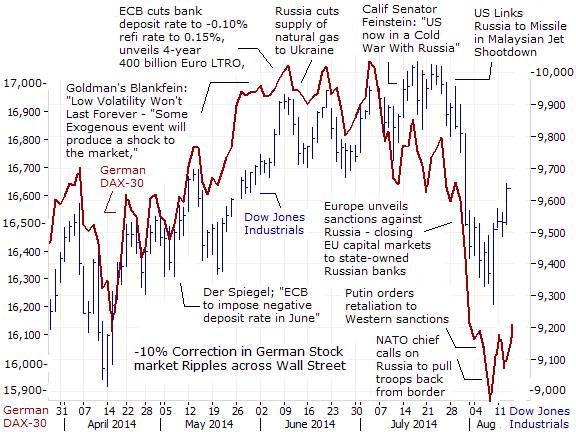
By definition, a “Black Swan” is a chain of events that radically deviates beyond what is normally expected and with only a 1% chance of happening. This term was popularized by Nassim Nicholas Taleb, a finance professor and former Wall Street trader. “If it’s a Black Swan Event, - it’s unpredictable.” Yet, “the odds are very good that unpredictable things will happen in a lifetime,” in a manner that can stump even the most sophisticated algorithims, because one just cannot include the truly unknown into a computer program. The 9/11 attacks would qualify as a Black Swan event. Some would argue that the sequence of events that led to the bankruptcy of Lehman Brothers in Sept 2008 was a Black Swan, certainly by those who never dreamed that half of the value of their homes could be wiped out.
Likewise, the recent sequence of events that led the European Union and the United States to launch stinging sanctions against Russia’s energy, banking and defense sectors, - can probably be regarded as a “Black Swan” sequence. The situation worsened dramatically after another unforeseeable event, - the downing of Malaysian flight MH-17 over Ukrainian territory on July 17th by what the West says was a Russian-supplied missile. As such, over the course of the past 4-weeks, the German DAX-30 index, - Europe’s top benchmark stock index began to stumble, skidding -11% from the psychological 10,000-level to as low as 8,920, as the specter of economic warfare with Russia became a reality. In turn, the slide in the German DAX acted as a catalyst that knocked the Dow Jones Industrials index -4% lower.
German companies are some of Russia’s biggest trade partners, and if the deepening standoff between the West and Moscow is sustained for an extended period of time, Germany’s blue-chip DAX-30 companies could feel the pinch. Germany exported about €36-billion worth of goods to Russia last year, from defense to car manufacturing, almost a third of the EU’s total, and some 6,200 German firms are active in Russia with €20-billion of direct investments. Despite active lobbying by German industrialists, Chancellor Angela Merkel has backed a hard line with Moscow, supporting the imposition of tougher economic sanctions by the EU.
Mr Taleb says protecting against Black Swan Events should be the cornerstone of any financial planning. However, die-hard “Buy-and-Hold” investors disagree, arguing that the Fed can always be relied upon to come to the rescue of the ultra-wealthy class, no matter what unforeseen crisis erupts and upends the markets. With a long-term view, any correction of -10% or more is considered by “Buy-and-Hold” enthusiasts as a chance to buy US-stocks at a bargain price, with new found profit potential. And history does show this has been the case. The US-stock market has overcome varying degrees of economic recessions and unexpected financial and geopolitical crisis over the past few decades, - because the Fed has always come to the rescue of the equity markets, with injections of cheap money and clandestine intervention in the futures market, dubbed the “Greenspan – Bernanke Put.”
Central Bankers and Cohorts warn about Market Risks, By now, it’s almost universally recognized that main aim of the Fed’s radical monetary policies, supported by its G-7 central bank allies, is to push investors into the stock markets. Dallas Fed chief Richard Fisher warned 2-½ years ago that the markets were hooked on the Fed’s “monetary morphine,” and Bank for International Settlements (BIS) noted 1-¼ year ago that the European and US-stock markets were “under the spell” of the world’s central bankers, with cheap money driving stock prices to record highs despite a lack of good economic news.
Even though the Euro-zone’s economy has remained stagnant, and corporate earnings are disappointing, investors continue to bid-up EuroStoxx prices. On Wall Street, there hasn’t been a correction of -10% or more, for the past 36-months. There’s only been four other times since World War II that US- stocks evaded a correction for as long as the current 36-month stretch. Historically, corrections of -10% or more occur about one every 18-months.
While Fed officials are happy to see the stock market hit new all-time highs, there’s also a growing concern, that if left unchecked, - “irrational exuberance” could kick in, and the stock market could suddenly go parabolic - into what’s called a “Melt-up.” If that happens, the rally would become unsustainable and would inevitably be followed by a nasty -10% correction that could possibly morph into a grizzly Bear market, - or a loss of -20% or more. In turn, losses of -20% or more could cause serious problems for the US-economy.
As such, several actors in the brokerage business and central bankers have started to issue a chorus of cautious comments on the stock markets in recent weeks, in what appears to be a concerted effort to take some the of steam out of the “Least Loved” Bull market, and shake out some of the speculative froth. In doing so, central planners aim to restore the framework of two way market, and prevent the outbreak of a “Melt-up.” Policymakers usually turn to “Jawboning” as the first line of intervention to influence trader psychology.
First in the batter’s box was Goldman Sachs chief Lloyd Blankfein who told viewers of CNBC on June 12th, that the “low level of volatility (in the stock market) won’t last forever.” With the S&P-500 index opening at the 1,942-level, Blankfein warned quite prophetically that, “Stocks are rather calm, but investors need to be vigilant against complacency, because it can lead to shocks in the market. The luxury of a steady, calm, quiet market might last for a while, but it can’t last forever. The danger of some exogenous event that’s going to cause people to have to reset their portfolios, - constantly lurks. There is always something coming that we don’t know about because nobody knows what the future is. My most important skill is to worry about everything. I am highly paranoid,” Blankfein added.
Five weeks later, Blankfein’s warnings appeared to be prophetic. On July 19th, there was a “Black Swan” event that occurred out of nowhere and began to ruffle the markets’ feathers. US-intelligence officials concluded that Moscow gave the SA-11 Gadfly surface-to-air missile antiaircraft system to pro-Russia separatists in eastern Ukraine that shot down Malaysia Airlines Flight-17, killing all 298-passengers aboard. On July 21st, Senate Intelligence Committee chairwoman Dianne Feinstein declared the US was in a new “Cold War” with Russia. “I think the world has to rise up and say, we’ve had enough of this,” she said.
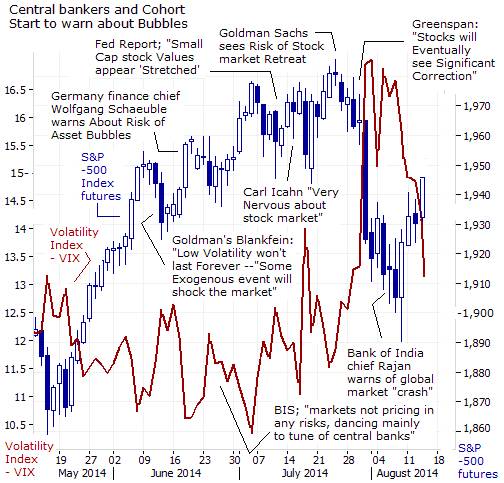
One June 29th, the BIS reiterated its warning that the G-7 central banks could keep monetary policy “too loose for too long, with potentially damaging consequences.” “Ultra low interest rates and the failure of policy to lean against the build-up of financial imbalances are in danger of making the global economy permanently unstable.” Instead, “monetary policies are needed to “tame the financial cycle” and “lean against financial booms, rather than just ease aggressively and persistently during busts,” the BIS advised.
On July 15th, the Federal Reserve issued an unusual warning, saying the valuations of small cap companies, listed in the Russell-2,000 index, social media and biotechnology shares, and lower-rated corporate debt, (junk bonds) appear to be “stretched,” with ratios of prices to forward earnings remaining high relative to historical norms,” the Fed said in its semi-annual Monetary Policy Report delivered to Congress.
On July 16th, Carl Icahn, the “King of Corporate Raiders,” - told CNBC that he was “very nervous about the US equity markets.” On July 17th, Bank of America Merrill Lynch joined the growing ranks of Wall Street strategists who think a -10% correction isn’t too far away. “A necessary condition for an equity market correction is greed and measures of greed are increasingly boosting the case for volatility and a correction in the autumn, in our view.”
On July 22nd, German Finance chief Wolfgang Schäuble added his voice to the naysayers, in a interview with newspaper Handelsblatt. “We cannot just leave the prevention of (asset) bubbles to the state supervisors. Central banks must keep that in mind when they take their decisions about money supply,” Schäuble said.
On July 26th, Goldman Sachs analysts did a 180-degree turnaround, suddenly warning about a pullback, saying “Global equities and bonds may retreat in the next three months, with stocks at risk of a brief selloff, as rising inflation boosts yields.” On July 30th, Pimco’s bond chief, Bill Gross warned; “investors should say “good evening” to the prospect of future capital gains in asset markets as interest rates are set to rise while the economy grows at a slow pace.”
However, when these words of caution failed to nudge the markets out of their serene sense of complacency, it was left to former Fed chief “Easy” Al Greenspan to throw down the gauntlet and strike a little bit of fear into the marketplace. On July 30th, Greenspan rocked the markets, saying, “The stock market has recovered so sharply for so long, you have to assume somewhere along the line we will get a significant correction,” he said in an interview on Bloomberg Television’s “In the Loop.” “Where that is, I do not know,” he added.
The impact of Greenspan’s verbal intervention was felt the next day, when the S&P-500 index plunged 40-points lower, to close at the 1,930-level and the Dow Jones Industrials plunged -317-points, to close at 16,563-points. The CBOE’s Volatility Index, known as VIX, which measures the cost of purchasing insurance as a hedge against a decline in the S&P-500 index jumped to above 16.5 on July 31st, after trading at a seven year low of 10.5 in the beginning of July. Greenspan was able to engineer the minor pullback, even though S&P-500 companies were beating earnings and revenue estimates by a significant margin.
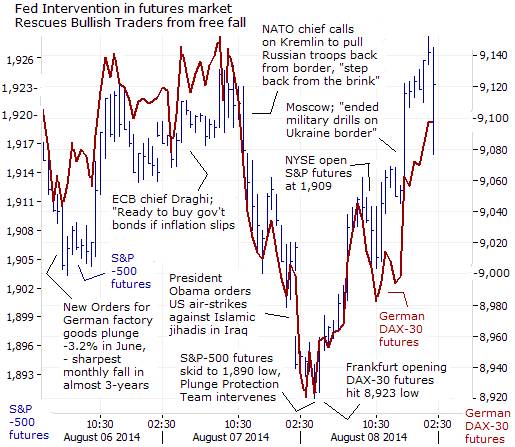
However, the shakeout in the US-stock markets was also the result of a steeper -10% correction in the European equity markets, which in turn, were negatively affected by the rising tide of confrontation with Russian kingpin Putin and his cohorts at the Kremlin. The Pentagon reported a flow of heavy weapons from Russia, including tanks and rocket launchers, to the separatists battling Kiev’s forces in eastern Ukraine. The Russian military fired artillery shells at Ukrainian army positions, and two Ukrainian fighter aircraft were shot down over their own airspace. Speculation was rife that Putin might order the Russian army into Ukraine.
Market sentiment was worsened by a report showing new orders for German factory goods had plunged -3.2% in June - the steepest monthly decline since Sept ‘11. New orders from countries in the Euro-zone plunged by a stunning -10.4%. Also, the market learned that the Italian economy shrank -0.2% in the second quarter, taking economists by surprise. The second straight decline in Italian economic output was caused in part, by a slump in exports, and was the first concrete sign that friction with Russia were hurting the European economy.
However, these negative signals about the Euro-zone economy didn’t rattle the EuroStoxx index. That’s because the European Central Bank (ECB) chief Mario Draghi, was quick to inform traders that the ECB is ready to print massive amounts of Euros, and buy sovereign bonds if necessary to prop-up the markets. Draghi said he expected banks to take up to €850-billion of the ultra-cheap four-year loans, which will be tied to lending to smaller companies, which would also serve to weaken the Euro’s exchange rate.
Despite Draghi’s verbal intervention and promise of massive liquidity injections, there was another “Black Swan” moment, - on August 7th, when the markets briefly spiraled lower after NATO’s Secretary General Anders Fogh Rasmussen called on the Kremlin to pull its troops back from the border with Ukraine and “step back from the brink.” The specter of an outright military confrontation between Russia and NATO, over control of strategic territory in the Ukraine, sent the German DAX-30 index and the S&P-500 index reeling. The panic selling went into overdrive on the night of August 7th at around 11-pm EST, - when US President Barack Obama ordered airstrikes in Iraq against the jihadists of the Islamic State.
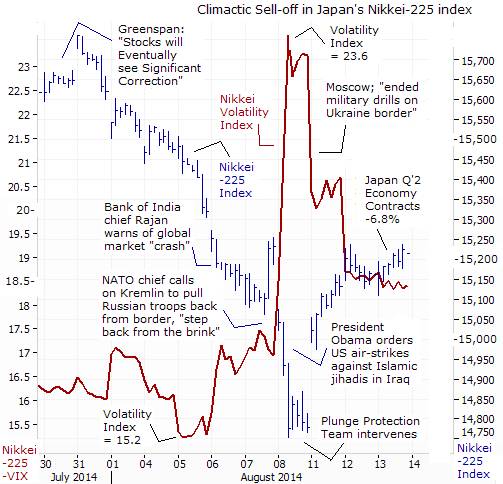
In Tokyo, the Nikkei-225 index plunged -3% after the opening on August 7th and closed at 14,778, - the low of the day, - suffering its biggest daily decline in five months, as investors were gripped with fear that the crises in Ukraine and in Iraq could disrupt Japanese exports. Each of the 33-sector sub-indexes on the Tokyo Stock Exchange posted losses as investors rushed to reduce exposure to risk assets. Just a week earlier, the Nikkei-225 index had reached a six-month high at 15,759, on expectations of increasing purchases by the country’s largest pension fund. Instead, the Nikkei Volatility index spiked up to as high as 23.6, up from a historic low of 15.2 hit last month, as investors rushed to insure themselves against losses. The broader Topix fell -2.4% to 1,228, with trading volume +30% above its average.
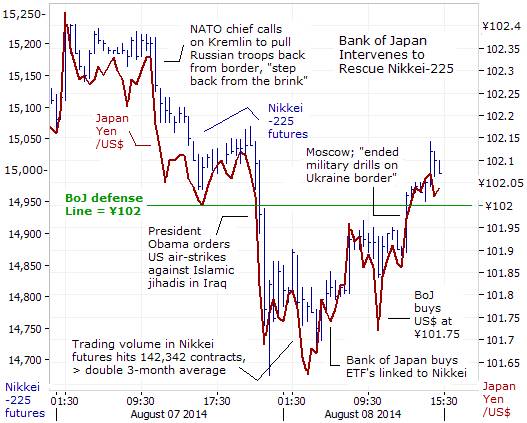
Obama’s announcement about airstrikes against ISIS triggered a knee-jerk panic selling spree that knocked the nearby Nikkei-225 futures contract to 14,700. Trading volume in futures shot up to 142,342 contracts, more than double the average in the past three months. Likewise, in a chain reaction, German DAX-30 index futures skidded to below the psychological 9,000-level, and the S&P-500 index futures fell below the 1,900-level. In turn, yen carry traders scrambled to unwind margin loans, and briefly pushed the US$ fell below ¥102, where the Bank of Japan has staunchly defended the yen’s dirty float for most of this year.
However, prior to the close of the Tokyo Stock Exchange, the Bank of Japan (BoJ) began buying ETF’s linked to the Nikkei-225 index, to stabilize the market. The BoJ intervened in the currency market, purchasing the US$ at around ¥101.75, to keep the carry trade intact. At the opening of the Frankfurt Stock Exchange on the morning of August 8th, - traders noticed a sizeable up-tick in the Dow Jones Industrials and S&P-500 futures market. Traders suspected the US-Treasury’s “Plunge Protection Team,” (PPT) was busy at work, - purchasing stock index futures, in order to put a safety net under the markets. As such, at the NYSE opening, six hours later, the S&P-500 index futures market was Ûpoints above its intra-day bottom at the 1,890-level. Likewise, the German DAX-30 index rebounded +120-points from its intra-day bottom low of 8,920 to reach the 9,040-level. In turn, Nikkei futures rebounded +300-points off their panic bottom low, to close above the 15,000-level, by day’s end. The rally in Nikkei futures was supported by short covering in the US$ to above ¥102.
There wasn’t any public news to explain these “miracle” rallies. However, on August 8th, at 2:08-pm EST, or about 2-hours before the NYSE close, Russia’s Defense Ministry issued a statement, saying it had finished military exercises along Ukraine’s border. “Aircraft taking part in exercises have been redeployed from temporary to their permanent air bases, anti-aircraft missile their permanent positions,” Russia’s Interfax news agency quoted the defense ministry’s news service as saying. The statement ushered in a big sigh of relief for jittery stock market Bulls, and enables the equity markets in Germany, Japan, and the US, to recoup more of the previous losses that were caused by Greenspan’s warning about a correction.
The Kremlin Grapples with Economic threats on Multiple fronts, By pulling back from the brink of a military confrontation with NATO, the Kremlin has won a little reprieve for the Russian rouble and its credit markets. The rouble had fallen to an all-time low of 36.73 per US$, following Moscow's decision to ban most food imports from the West in retaliation for sanctions over Ukraine, but recovered to 36-roubles /US$ today. One of the biggest unknowns is how many foreign investors and Russians will dump their roubles for other currencies, or Gold, if relations with the West sour further. Around $75-billion poured out of Russia in the first six months of this year, - the fastest pace in more than four years.
On July 25th, the Russian central bank unexpectedly hiked its 1-week repo rate, çbasis points (bps) higher to 8%, trying to head-off capital flight from Moscow's already
battered currency and financial markets. The central bank, in one of its most hawkish statements in recent years, said the çbps rate hike was due to higher inflation and geopolitical tensions. The Bank of Russia has hiked its 1-week repo rate by a total of +250-bps so far this year, and Russia’s 6-month Libor rate has jumped to 10.30%, in order to defend the rouble’s exchange rate. Since the start of July, the yield on Russia’s 5-year note has surged to as high as 10%. However, after Moscow backed away from the brink of a military confrontation with NATO on August 8th, the 5-year yield has dipped to 9.44% today.
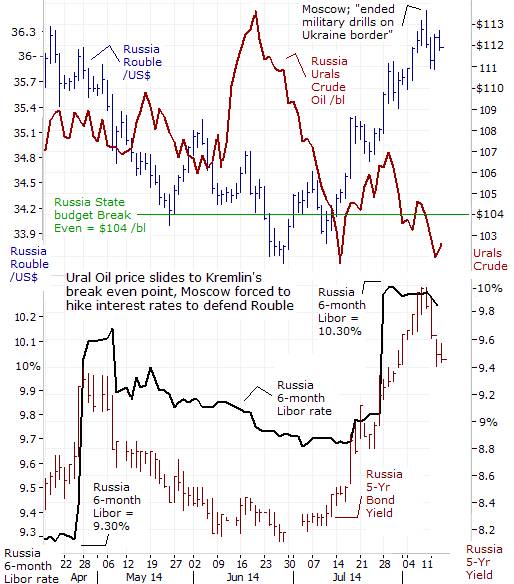
Still, Russia and the West are engaged in a mini trade war that will produce winners and losers. For Moscow, the primary battle is over the rouble’s exchange rate. A further weakening of the roubles’ exchange rate against the Euro and US$, could lead to higher inflation and interest rates, and if sustained for an extended period of time, might topple Russia’s $2-trillion economy into a recession. Russia’s economy grew at an annualized rate of +0.8% in the second quarter after shrinking -0.5% in the preceding three months. Russia, earns $350-billion annually by exporting its oil and natural gas. However, capital and technical expertise are fleeing the country, investment is shrinking, and inflation hit 7.8% in June - well above the central bank’s forecast of +6.5% for the whole of 2014. “If high inflation risks persist, the Bank of Russia will continue raising the key rate,” the central bank warned.
For all the sanctions Western leaders can throw at Russia, the biggest threat to Putin’s hold on power is something beyond his control: the price of crude oil. The Kremlin’s finances are heavily dependent on exports of crude oil and natural gas, - (tied to the price of oil), and their prices are closely monitored. As long as oil, which accounts for 50% of Russia’s tax revenues, remains above the average of $104 per barrel written into the 2014 budget, Moscow has little immediate need to worry. However, the alarm bells will start ringing if Urals blend crude oil falls significantly below $100, forcing the Kremlin to dip into its $470-billion stash of foreign currency reserves, in order to maintain government spending at current levels and prop-up an economy that’s already flirting with a recession. Moscow’s School of Economics estimates that a $10 drop in oil prices would strip 700-billion roubles ($20-billion), or 5%, from Russian budget revenues a year. That translates to about -1% of GDP. Local economists estimate that a sustained $10 price drop could cost -4% in annual economic growth. If the price of Urals blend crude oil tumbles to $75 and stays there, Russia could have regime change.
While Russia goes on pumping oil, the rest of the world is developing new sources of energy and energy-saving technologies. Oil from shale has boosted US-oil output by 3-million barrels per day (bpd) to roughly 8.5-million bpd today. The nation’s output is forecast to climb to 9.28 million barrels a day next year, - the highest since 1972. On the demand side of equation; Europe and the US reduced their consumption by 440,000-bpd over the past 12-months. German demand for oil -4% less than a year ago, - and the same for Italy and Japan.
The economic sanctions and trade bans that have been put into place will chip away at the vitality of Russia’s and the Euro-zone’s economies in the months ahead. Already, the Euro-zone’s GDP ground to a halt in the second quarter as Germany's economy shrank -0.2%, and France's stagnated at zero growth for a second quarter in a row. The zero growth rate for the Euro-zone as a whole is cause for alarm throughout the 18-nation region, which is already feeling the deleterious effects of sanctions before they begin to bite.
Periodic sell-offs in the European stock markets could rattle the S&P-500 index. However, US-investors can rest easy knowing that the “Plunge Protection Team” is monitoring the market, 5-days per week, and 24-hours per day, and will intervene to put a safety net under the market to prevent a -10% correction from unfolding. However, the PPT is not adverse to -5% pullbacks from time to time, to prevent the emergence of frothy bubbles. Still, taking out cheap volatility insurance (ticker VXX), without abandoning long positions is a good idea.
This article is just the Tip of the Iceberg of what’s available in the Global Money Trends newsletter. Global Money Trends filters important news and information into (1) bullet-point, easy to understand reports, (2) featuring “Inter-Market Technical Analysis,” with lots of charts displaying the dynamic inter-relationships between foreign currencies, commodities, interest rates, and the stock markets from a dozen key countries around the world, (3) charts of key economic statistics of foreign countries that move markets.
Subscribers can also listen to bi-weekly Audio Broadcasts, posted Monday and Wednesday evenings, with the latest news and analysis on global markets. To order a subscription to Global Money Trends, click on the hyperlink below,
http://www.sirchartsalot.com/newsletters.php
or call 561-391- 8008, to order, Sunday thru Thursday, 9-am to 9-pm EST, and on Friday 9-am to 5-pm.
This article may be re-printed on other internet sites for public viewing, with links to:
http://www.sirchartsalot.com/newsletters.php
Copyright © 2005-2014 SirChartsAlot, Inc. All rights reserved.
Disclaimer: SirChartsAlot.com's analysis and insights are based upon data gathered by it from various sources believed to be reliable, complete and accurate. However, no guarantee is made by SirChartsAlot.com as to the reliability, completeness and accuracy of the data so analyzed. SirChartsAlot.com is in the business of gathering information, analyzing it and disseminating the analysis for informational and educational purposes only. SirChartsAlot.com attempts to analyze trends, not make recommendations. All statements and expressions are the opinion of SirChartsAlot.com and are not meant to be investment advice or solicitation or recommendation to establish market positions. Our opinions are subject to change without notice. SirChartsAlot.com strongly advises readers to conduct thorough research relevant to decisions and verify facts from various independent sources.
Gary Dorsch Archive |
© 2005-2022 http://www.MarketOracle.co.uk - The Market Oracle is a FREE Daily Financial Markets Analysis & Forecasting online publication.



